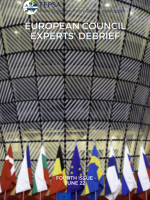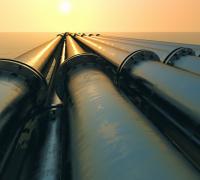Energy issues
To date, the EU has adopted six sanction packages in response to Russia’s aggression in Ukraine. Reaching consensus, however, once again flashed out discrepancies among the Member States. Countries that have been consistently advocating for the toughest measures are largely those whose national security and energy policies reflected distrust in Moscow’s influence over the last decades.
Lithuania and Poland are cases in point here. Already in December 2021, in the so-called ‘Lublin triangle’ meeting, the presidents of Lithuania, Poland and Ukraine called for a Western response to the Russian troops’ build-up near the Ukrainian border. President Zelensky emphasised a need for ‘powerful preventative actions, powerful serious sanctions to exclude any thought about escalation’, adding that Lithuania, Poland and Ukraine are the vanguards of deterrence against the Russian threat.
Ever since the outbreak of war in Ukraine, Poland and Lithuania consistently called for greater unity within the EU and stronger sanctions on Russian fossil fuels. They also urged their EU partners not to cave into pressure for payments for Russian gas in rubles. Following the EU’s prohibition on imports of Russian coal and oil, Lithuania and Poland call for gas sanctions to follow. This consistent approach has been matched by their domestic energy policies focused on diversification of supply, which earlier also manifested in their strong opposition to the Nord Stream 2 project. Although a number of strategic projects in the Polish and Lithuanian energy sectors are coming to fruition today, they are the outcomes of the two states’ long-term strategic visions of energy independence from Moscow’s grip. These drives were partially motivated by the historical legacy and partially by the repeated episodes of energy blackmail from Russia in the CEE region.
The Soviet-era energy infrastructure has kept both countries dependent on Gazprom even after the collapse of the USSR, which has prompted the diversification of gas supply routes despite geographical limitations. Tied to a single pipeline delivery system from Russia, the Lithuanian gas sector was left vulnerable to Russian influence. As early as in 2006, plans of building a liquified natural gas (LNG) terminal started circulating in the parliament. Yet, it was not before 2011 that the project landed on the governmental agenda, largely, as a reactionary measure against the politically motivated natural gas price increase. The LNG terminal project encompassed different visions of national, regional, private and state-owned projects, yet neither of the options offered an easy way out of Gazprom’s regional monopoly, as it also happened to hold shares in national gas companies across all three Baltic States.
Lithuania seized the opportunity by adopting the most stringent form of the EU’s Third Energy Package (2009) which backed up unbundling procedures and laid the foundations for the creation of a national gas market. The floating storage and regasification unit (FSRU) symbolically named ‘Independence’ completed the LNG project and enabled the diversification of gas supply in 2014. Although the economic viability of the terminal was contested throughout the years, the critical importance of the infrastructure was justified on security grounds instead. Today, the skeptical voices have gone silent. Alongside regional gas infrastructure, such as the LatviaLithuania interconnection ELLI that doubled bidirectional flows (2020), and the GIPL interconnector with Poland (2022), the national LNG terminal de facto improved regional security of supply and laid foundations for further integration of the gas market. Therefore, Lithuania’s objective of reaching energy independence is finally materialising, balancing on two pivots: diversification and interconnectedness.
Poland opened its first LNG terminal in Świnoujście in 2016, named after the deceased President Lech Kaczyński, who made decreasing of Poland’s energy dependence on Russia one of the top priorities of his presidency (2005- 2010). Currently, the terminal is undergoing a major expansion that will provide additional supporting infrastructure and further increase its regasification capacity by 2024. Additionally, the plans for a new LNG terminal in Gdansk are in progress, with the expected operational status of the new terminal by 2028.
When it comes to pipeline infrastructure, the strategic Baltic Pipe to deliver Norwegian gas from the North Sea via Denmark to Poland will become operational in Autumn 2022, reaching its full capacity at the beginning of 2023. The corridor is also suitable to transfer gas from Poland to the Danish market, further adding to the flexibility and security of energy supply in the region. The timing of these initiatives is key, as the expiration of Poland’s long-term contract with Gazprom in December 2022 was the key driver to stick to the deadlines. It is also one of the reasons, why cutting the gas supply to Poland by Russia at the end of April 2022 did not raise energy security concerns in Poland, which had enough storage and diversified gas supply routes to meet its future domestic demand.
Polish gas infrastructure is also increasingly linked to the regional energy market through several interconnectors. The above mentioned GIPL Interconnector between Poland and Lithuania started commercial operation in May 2022. It allows to adjoin the LNG terminals in Klaipeda and Świnoujście, as well as adjust the gas transits to the shifting demand-supply dynamic in the region due to bidirectional flows. Polish system is also integrated further with the CEE gas infrastructure through interconnector with Slovakia (2021), and the plans for the Czech-Polish interconnector are on the table. The latter has been repeatedly postponed from 2021 to 2023 and then again to 2027, however, in the current geopolitical context this timetable is likely to be accelerated.
The cases of Lithuania and Poland illustrate, that their unfavourable geographical location prompted both states to diversify energy supply routes and diminish dependence on Russian fossil fuels over the years. These policy moves stemmed from the two states’ strategic security considerations, which now translate into calls for an ever-stronger energy sanction regime against Russia and which make their domestic energy systems more resilient to its possible aftermath. In the face of Russian aggression in Ukraine, Polish authorities assured in the following months that Poland is ready for the impact of the EU’s energy sanctions. Lithuania was the first country able to completely cut off energy ties with Russia. The Lithuanian President tweeted: ‘If we [Lithuania] can do it, the rest of Europe can do it too’. However, these decisions result from decades-long strategic energy sector development and political determination that took time and significant investment, and that at times ran against purely economic rationale.
This text by Izabela Surwillo & Veronika Slakaityte was originally published in a briefing paper by TEPSA. Read the full EUCO Debrief here
DIIS Experts




